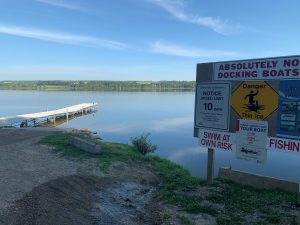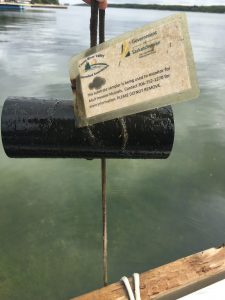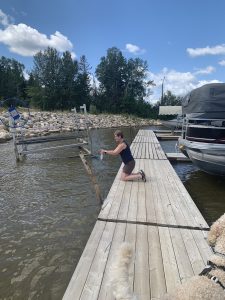




In 2015, the CRVWA launched an Adult Invasive Mussel Monitoring (AIMM) project at Wakaw Lake. 13 substrate samplers were placed in the lake at participating lakefront property owners’ locations, either deployed from a dock, boat launch, or other feature directly in the water. These substrate samplers are made up of lengths of PVC pipe with concrete filling about half of the pipe section. Bolts are attached to secure a rope to the sampler, and then the rope is attached to the volunteer lakefront property owners’ dock or boat lift. These samplers provide a firm surface for the zebra and/or quagga mussels to attach to, should there be adult mussels of these species present in the waterbody. Unlike native mussels, which prefer the soft, sandy lake bottom, zebra and quagga mussels prefer to live on firm surfaces. The Saskatchewan Ministry of Environment has created a fact sheet- Saskatchewan Adult Invasive Mussel Monitoring (AIMM) with more information about zebra and quagga mussels.
Our AIMM project expanded in 2016 to include Kipabiskau Regional Park and Tobin Lake, in 2017 to include Lake Lenore, Mcbride Lake, Greenwater Lake, Marean Lake and Codette Lake, and in 2018 to include Struthers Lake as well as continued monitoring of substrate samplers at Wakaw Lake. For more information, or to become involved, contact our office at 306-752-1270
As part of the AIMM project, we have partnered with the Fish and Wildlife Development Fund Invasive Species Centre to promote Clean Drain Dry or look at the Stop Aquatic Invasive Species . Clean Drain Dry is a practice that can easily be adopted by recreational boaters, and involves visually inspecting boats when they are taken out the water; removing any debris (including plants, mud and animals); wash using high pressure, hot tap water away from storm ditches, drains and waterways; draining all on board water from live wells, bilge, ballast tanks and motors; and thoroughly dry watercraft, equipment and all related gear. Watch this video for more information about Clean Drain Dry, or contact our office to arrange a Clean Drain Dry demonstration at your lake or event.
It is also important to properly dispose of unwanted or leftover bait; and aquarium pets, plants and water into the trash. These items can include plants, animals and pathogens that have the ability to become invasive in our native water bodies. Never release or dispose of them into wetlands, lakes, rivers, or streams.
The CRVWA is also testing for veliger larvae which is the beginning stage for the zebra mussels and quagga mussels. These larvae spread fast and plentiful. The CRVWA goes to the same lakes as the AIS monitoring sites. They will check the substrate samplers and collect a water sample from the lakes. This water sample is collected at each of the docks by using a fine mesh net and small organisms are collected in it. This water sample is then put in a smaller sample container and send off to be checked for veliger’s.
This summer 2021 the CRVWA is participating in a pilot project and collecting environmental DNA. Watershed groups are testing high traffic lakes and rivers in Saskatchewan such as Wakaw lake, Greenwater Lake, and Tobin Lake. Environmental DNA is DNA that is collected or taken from the environment. This means that it is not just one species of plant or organism that is collected. The eDNA will be able to test for amphibians, cellular material like skin cells, feces, saliva urine. The data the watershed and Ministry of Environment is specifically looking for is invasive zebra mussels. Invasive species are species that do not belong in that habitat and will overtake the habitat and cause problems for native species. Native species live in that habitat and help keep it healthy and productive.
At these high traffic areas watershed groups collect water from three different sites on the same lake at least 200m away from each other. Once the water is collected it all goes in one bag and the water passes through a filter. This filter is sterilized and will be what is sent in for testing. The filter collects the lakes eDNA and has a preservative put through it and is sent to Ontario for analysis. There is a lot of focus on testing for zebra mussels as they cause a lot of expensive problems for waterbodies. It is extremely important for the people of Saskatchewan to be aware of what is in their water and how they can help keep the water clear from invasive species.


